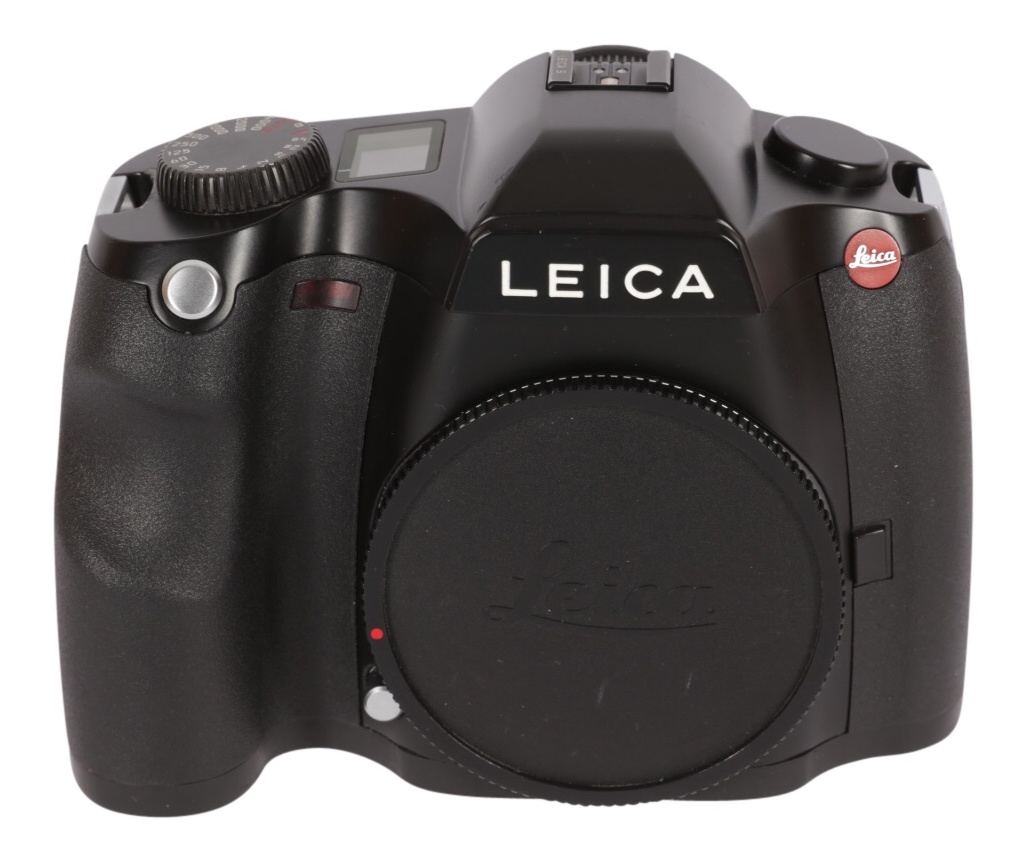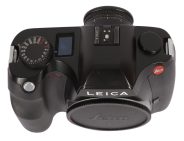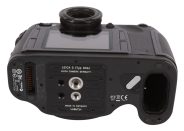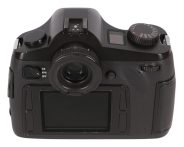Leica S (Typ 006)
Medium format AF digital SLR camera
Specification
| Production details: | |
| Announced: | September 2012 |
| Order No.: | 10803 |
| System: | ● Leica S (2008) |
| Format: | |
| Maximum format: | Medium format 45x30 |
| Imaging sensor: | 45 × 30mm CCD sensor |
| Resolution: | 7500 × 5000 - 38 MP |
| Sensor-shift image stabilization: | - |
| Mount and Flange focal distance: | Leica S [53mm] |
| Shutter: | |
| Type: | Focal-plane |
| Model: | Electronically controlled |
| Speeds: | 125 - 1/4000 + B |
| Exposure: | |
| Exposure metering: | Through-the-lens (TTL), open-aperture |
| Exposure modes: | Programmed Auto |
| Aperture-priority Auto | |
| Shutter-priority Auto | |
| Manual | |
| Physical characteristics: | |
| Weight: | 1260g |
| Dimensions: | 160x120x80mm |
| Accessories: | |
| Body cap: | 16021 |
Manufacturer description
Solms, Germany (September 17, 2012) – Leica Camera presents a new camera in the Leica S-System portfolio, a revolutionary digital camera concept to meet supreme professional requirements. The next generation in the successful line, the Leica S offers increased imaging quality and sensor sensitivity, predictive autofocus, higher speed and improved handling. Numerous enhanced functions contribute to the camera’s further acceleration and greater security of the professional photographic workflow. In addition to the new camera body, three lenses have been added to the S-System portfolio, significantly expanding the capabilities of the system: the Leica Super-Elmar-S 24 mm f/3.5 ASPH. super-wide, the Leica Vario-Elmar-S 30-90 mm f/3.5-5.6 ASPH. and the Leica TS-APO-Elmar-S 120 mm f/5.6 ASPH. tilt/shift lens.
“This expansion of the system is further confirmation that the dedicated digital concept of the S-System sets new standards in the world of medium format photography while providing the speed and handling of a 35 mm SLR,” said Stephan Schulz, Head of Professional Imaging at Leica Camera AG. “In terms of its rugged resilience, reliability and versatility, the new Leica S is the first choice for photographers who refuse to make compromises.”
New Image And Sensor Board For More Quality And Higher Speed
One of the most remarkable innovations in the Leica S is its new image and sensor board. The upgrade of these electronic components has led to the increased imaging quality of the Leica S, as well as the improvement of noise characteristics, natural color rendition and the precision of its white balance. The latter function has now been extended to include a ‘Grey Card’ option that allows photographers to shoot a subject with a neutral grey area, such as a grey card, and define the white balance determined as a reference for all following photos to ensure a consistently precise color mood from beginning to end of a shoot. The extended sensitivity range of the sensor at both ends gives photographers more freedom of choice in the selection of exposure parameters. For example, the lower basic ISO setting of 100 allows longer working at maximum aperture in extremely bright conditions, while the maximum sensitivity of ISO 1600 enables them to capture noise-free images even under difficult lighting conditions. In addition, the double buffer memory of 2 GB and support of transfer rates up to 166 MB/s enables photographers to shoot continuous sequences of more than twice as many (up to 32) consecutive images in RAW format, at a full resolution of 37.5 MP. There is no limit to the number of consecutive images that may be captured in JPEG format. Images can be saved parallel to the original files in a choice of 37.5, 9.3 and 2.3 megapixels to provide photographers with a preview of the work in progress straight from the camera at the desired resolution.
Fast, Predictive Autofocus Module For Subjects In Motion
The upgraded autofocus module not only increases the speed, but also enhances focusing precision. In combination with its fascinating imaging quality, the Leica S sets new standards for professional action photography. To ensure that moving subjects remain sharp and can be swiftly tracked, the Leica S features a predictive autofocus. The camera compares past movements of the subject and computes the location of the subject at the time of exposure. The autofocus locks on to this computed point before the shutter release is pressed.
GPS System And Leveling Aid For Precision And Uncomplicated Workflows
The Leica S is the only professional camera to feature an integrated GPS module that can add the geographical positioning data of the exposure location to the Exif data of an image whenever necessary. This function allows the precise synchronization of the system time (internal clock) for any worldwide location where satellite signals can be received. With software (the professional image administration and processing tool, Adobe® Photoshop® Lightroom® 4 is supplied with the camera), every image can be shown on a map and tagged with a location name that can be used to locate the image in the future. The new dual-axis leveling aid (spirit level) displays its readout in the viewfinder to allow photographers to align the subject with absolute precision in the horizontal and vertical plane without the need for external aids.
Optimized Handling
The monitor screen offers a resolution of 920,000 pixels, a 3″ diagonal and full sRGB color space, as well as increased contrast and brightness to allow for greater precision when assessing images. The glass covering plate of the monitor screen is manufactured from tough, scratch-resistant Corning®Gorilla®Glass. The increased viewfinder coverage of 98 percent, additional information displayed in the viewfinder, optimization of the camera menu and a softer rubber coating for better grip all make the new camera easy to handle. Significantly faster navigation in the camera menu is now possible with the new integrated joystick control located on the back. Greater security in the control of studio flash systems is afforded by the new LEMO flash sync socket.
Advantages Of The S-System
The new Leica S possesses all the standard quality characteristics of the S-System including the large (30 x 45 mm) Leica Pro Format sensor and its microlens layer that guarantees consistently uniform brightness from corner to corner. Resembling all S-Lenses, the camera is extremely rugged and sealed against environmental influences such as dust and rain. The unique dual shutter concept offers photographers the choice of using the camera’s fast focal plane shutter or the central shutter of CS-version lenses that allows flash sync at shutter speeds up to 1/1000th of a second. The eight Leica S-System lenses currently available (five of which will also be available with a central shutter) offer photographers all focal lengths and a first-class tilt/shift lens. Furthermore, a wide range of medium format lenses from a number of other manufacturers can easily be mounted on the Leica S using adapters such as the S-Adapter H, which allows the use of Hasselblad H-Lenses with full support of all functions including autofocus, central shutter control and automatic aperture control.
Photographers never face compromises when they choose a Leica S due to details such as secure cable connections, multifunctional memory card slots, further improved energy efficiency and scratch resistant monitor glass. The Leica S stands alone as an ideal and extremely reliable tool for achieving maximum quality results both in the studio and on location, under even the most unfavorable conditions.
Together with the new Leica M, the Leica S marks the beginning of a new era in Leica’s product naming policy. In future, Leica M and S model names will omit the number suffix to emphasize the long-term significance and enduring value of the respective systems.
Purchase of the Leica S includes the Leica Protection Plan, offering photographers an extended warranty for a period of three years, as well as a replacement camera during repair. The Leica S will be available from select Leica dealers, including the Leica Store Washington DC, beginning in December 2012.
Special limited editions (2)
- Leica S (Typ 006) "Edition 100" - March 2014
- Leica S (Typ 006) "Summicron 100 Edition" (100 units) - August 2014



